Related Research Articles

A meteorite is a solid piece of debris from an object, such as a comet, asteroid, or meteoroid, that originates in outer space and survives its passage through the atmosphere to reach the surface of a planet or moon. When the original object enters the atmosphere, various factors such as friction, pressure, and chemical interactions with the atmospheric gases cause it to heat up and radiate energy. It then becomes a meteor and forms a fireball, also known as a shooting star; astronomers call the brightest examples "bolides". Once it settles on the larger body's surface, the meteor becomes a meteorite. Meteorites vary greatly in size. For geologists, a bolide is a meteorite large enough to create an impact crater.

A meteoroid is a small rocky or metallic body in outer space. Meteoroids are distinguished as objects significantly smaller than asteroids, ranging in size from grains to objects up to a meter wide. Objects smaller than meteoroids are classified as micrometeoroids or space dust. Most are fragments from comets or asteroids, whereas others are collision impact debris ejected from bodies such as the Moon or Mars.

A micrometeoroid is a tiny meteoroid: a small particle of rock in space, usually weighing less than a gram. A micrometeorite is such a particle that survives passage through Earth's atmosphere and reaches Earth's surface.
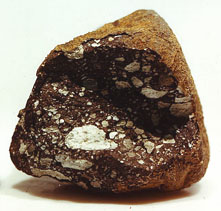
A lunar meteorite is a meteorite that is known to have originated on the Moon. A meteorite hitting the Moon is normally classified as a transient lunar phenomenon.

An iron meteorite fell on the Sikhote-Alin Mountains, in southeastern Russia, in 1947. Large iron meteorite falls have been witnessed and fragments recovered but never before, in recorded history, a fall of this magnitude. An estimated 23 tonnes of fragments survived the fiery passage through the atmosphere and reached the Earth.

Mesosiderites are a class of stony–iron meteorites consisting of about equal parts of metallic nickel-iron and silicate. They are breccias with an irregular texture; silicates and metal occur often in lumps or pebbles as well as in fine-grained intergrowths. The silicate part contains olivine, pyroxenes, and Ca-rich feldspar and is similar in composition to eucrites and diogenites.
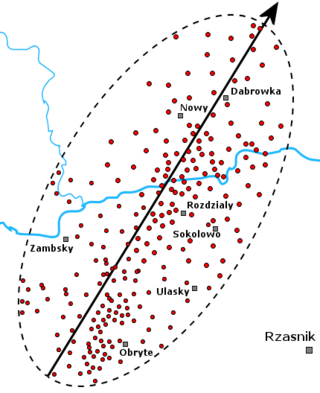
The term strewn field indicates the area where meteorites from a single fall are dispersed. It is also often used for the area containing tektites produced by large meteorite impact.
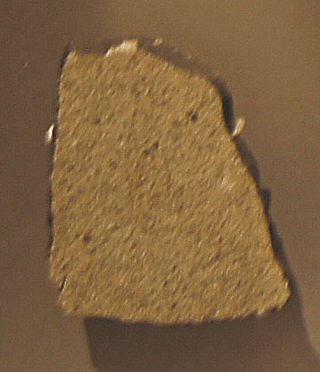
The Sylacauga meteorite fell on November 30, 1954, at 12:46 local time in Oak Grove, Alabama, near Sylacauga, in the United States. It is also commonly called the Hodges meteorite because a fragment of it struck Ann Elizabeth Fowler Hodges (1920–1972).

Brenham is a pallasite meteorite found near Haviland, a small town in Kiowa County, Kansas, United States. Pallasites are a type of stony–iron meteorite that when cut and polished show yellowish olivine (peridot) crystals.

Pultusk is an H5 ordinary chondrite meteorite which fell on 30 January 1868 in Poland. The event has been known as the stony meteorite shower with the largest number of pieces yet recorded in history. Made up of rocky debris, it consists of pyroxene or olivine chondrules deployed in mass plagioclase, there being also kamacite.

Park Forest is an L5 chondrite meteorite that fell on 26 March 2003 in Illinois, United States.
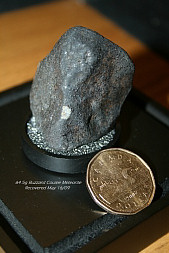
Buzzard Coulee is the collective name of the meteorites fallen on November 20, 2008 over Saskatchewan, Canada.

Neuschwanstein was an enstatite chondrite meteorite that fell to Earth on 6 April 2002 at 22:20:18 GMT near Neuschwanstein Castle, Bavaria, at the Germany–Austria border.
St-Robert is an ordinary chondrite meteorite fell on Quebec on June 14, 1994.

The Weston meteorite is an H4 ordinary chondrite meteorite which fell to earth above the town of Weston, Connecticut on the morning of December 14, 1807.
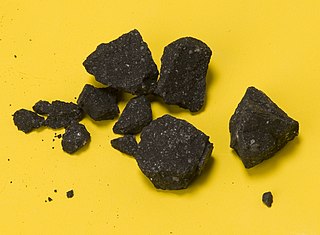
The Sutter's Mill meteorite is a carbonaceous chondrite which entered the Earth's atmosphere and broke up at about 07:51 Pacific Time on April 22, 2012, with fragments landing in the United States. The name comes from Sutter's Mill, a California Gold Rush site, near which some pieces were recovered. Meteor astronomer Peter Jenniskens assigned Sutter's Mill (SM) numbers to each meteorite, with the documented find location preserving information about where a given meteorite was located in the impacting meteoroid. As of May 2014, 79 fragments had been publicly documented with a find location. The largest (SM53) weighs 205 grams (7.2 oz), and the second largest (SM50) weighs 42 grams (1.5 oz).
This is a glossary of terms used in meteoritics, the science of meteorites.

The Chelyabinsk meteor was a superbolide that entered Earth's atmosphere over the southern Ural region in Russia on 15 February 2013 at about 09:20 YEKT. It was caused by an approximately 18 m (59 ft) diameter, 9,100-tonne (10,000-short-ton) near-Earth asteroid that entered the atmosphere at a shallow 18.3 ± 0.4 degree angle with a speed relative to Earth of 19.16 ± 0.15 kilometres per second. The light from the meteor was briefly brighter than the Sun, visible as far as 100 km (60 mi) away. It was observed in a wide area of the region and in neighbouring republics. Some eyewitnesses also reported feeling intense heat from the fireball.

The Chelyabinsk meteorite is the fragmented remains of the large Chelyabinsk meteor of 15 February 2013 which reached the ground after the meteor's passage through the atmosphere. The descent of the meteor, visible as a brilliant superbolide in the morning sky, caused a series of shock waves that shattered windows, damaged approximately 7,200 buildings and left 1,491 people injured. The resulting fragments were scattered over a wide area.
References
- ↑ The British and Irish Meteorite Society, Glossary
- ↑ Guidelines for meteorite nomenclature Archived 2010-04-17 at the Wayback Machine - Meteoritical Society - Committee on meteorite nomenclature.
- ↑ Kevin Kichinka. The art of collecting meteorites. Pennsylvania State University, Bookmasters, 2005.